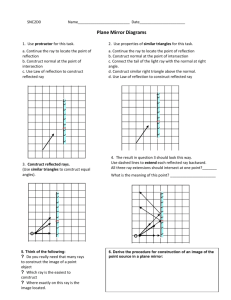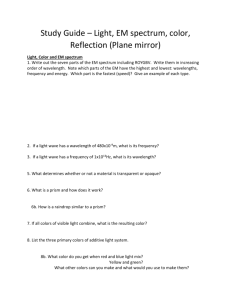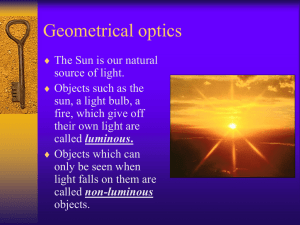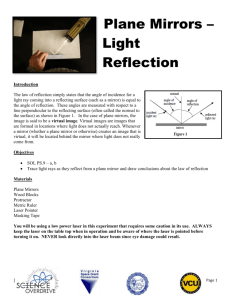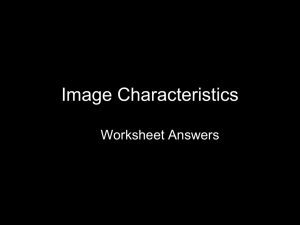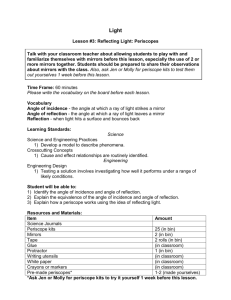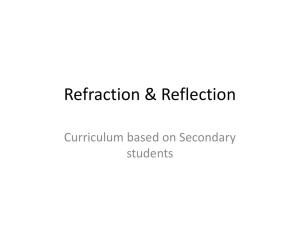group8 - light
advertisement
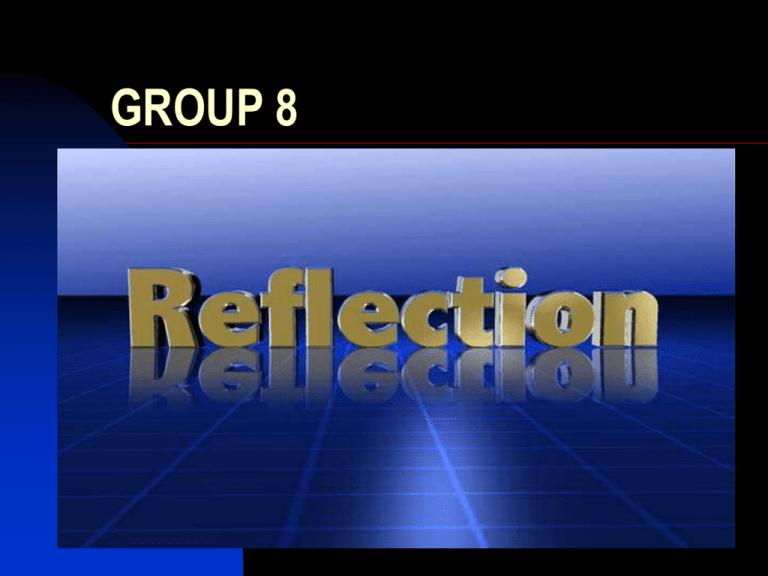
GROUP 8 Outcomes – Pre and Primary school Knowledge about the physical phenomena, reflection; Learn to work in a group; Be able to connect this phenomena with the real world: understand that the students meet it in their everyday life. Working with reflection in Pre school Playing with mirrors and torches To make the kids interested about the subject See their reflection in a mirror, and ask them why they think that they can see themselves. 4- 6 year old kids can have a lot of clever ideas about it. Working with reflection in Primary school We give to students 2 worksheets: one on the beginning about what the students know about the reflection (light) and one at the end to be able to show the students what they have learned. Make some experiments with groups about reflection; by help of computers and then discuss in groups and with the rest of the class about what happened. Have a program on the internet that simulates reflection. LEARNING OUTCOMES – Secondary school At the end of this lesson the students should be able to investigate the reflection of light by plane mirrors, and illustrate this using ray diagrams; demonstrate and explain the operation of a simple periscope Students should all be aware of light, and know that it is necessary for us to see. They should develop a basic understanding of light as a form of energy and understand that it is a wave that can be detected by our eyes. They should learn the everyday properties of light and some everyday applications worksheet To investigate the reflection of light by plane mirrors Apparatus Ray box, sheet of white paper, plane mirror, protractor. What is meant by a plane mirror? Plane mirror Ray box Blu-tac Stand the plane mirror on the sheet of white paper using blu-tac. Shine a ray of light from the ray box at the mirror as shown. Using a pencil, put two dots on the ray coming from the box and the ray bouncing back from the mirror. Draw a line on the paper along the back of the mirror. Take away the mirror and the ray box. Draw lines through the dots to show where the two rays of light were. The ray of light striking the mirror from the box is called the incident ray. The ray of light bouncing back from the mirror is called the reflected ray. Draw a line perpendicular to the mirror line at the point where the rays meet. This line is called the normal. i r Reflected ray Incident ray Normal The angle between the incident ray and the normal is called the angle of incidence, i The angle between the reflected ray and the normal is called the angle of reflection, r Measure i and r on your diagram, using a protractor. i = ____________ r = ___________ Repeat the investigation using different angles on incidence. How will you change the angle of incidence? Measure i and r each time and fill in the table. Angle of incidence iAngle of reflection r Write down what do you notice about i and r each time. The students will build a periscope How does my periscope work? Light always reflects away from a mirror at the same angle that it hits the mirror. In your periscope, light hits the top mirror at a 45-degree angle and reflects away at the same angle, which bounces it down to the bottom mirror. That reflected light hits the second mirror at a 45degree angle and reflects away at the same angle, right into your eye. Can I make a periscope with a really long tube? You can make your peri- scope longer, but the longer the tube is, the smaller the image you'll see. Periscopes in tanks and submarines have magnifying lenses between the mirrors to make the reflected image bigger. What is the role of the teacher? In pre school the teacher has an active role. The kids are learning by doing/ playing. The teachers needs to focus more on just for example mirrors. In primary school the subject had to be more scientific, and the teacher has more of a “teaching role”. The teacher is also a support when the students are working with their experiments. In secondary school the teacher has to be more scientific, and to have more of a “teaching role”. In secondary school the teachers can focus more on light in general. What is your perspective on Science? Science doesn’t have to be complicated and just for “smart people”. Kids and students can actually touch it. Can you use ICT – why/ why not? We are using ICT when the students are making the periscope and when they are looking for the experiments. We are using the ICT when the students use programs on internet that simulates reflection. Do you have a connection to the surrounding society? The students can recognize the reflection of light when they can see it in everyday life. The students will understand how periscopes are used in submarines. Have you considered one or more “isms” in your activity? Essentialism: The subject is in focus. The teachers are important because they have the knowledge. Progressivism: The student is in focus. The students are working with hands on projects. Thank you for your attention!

